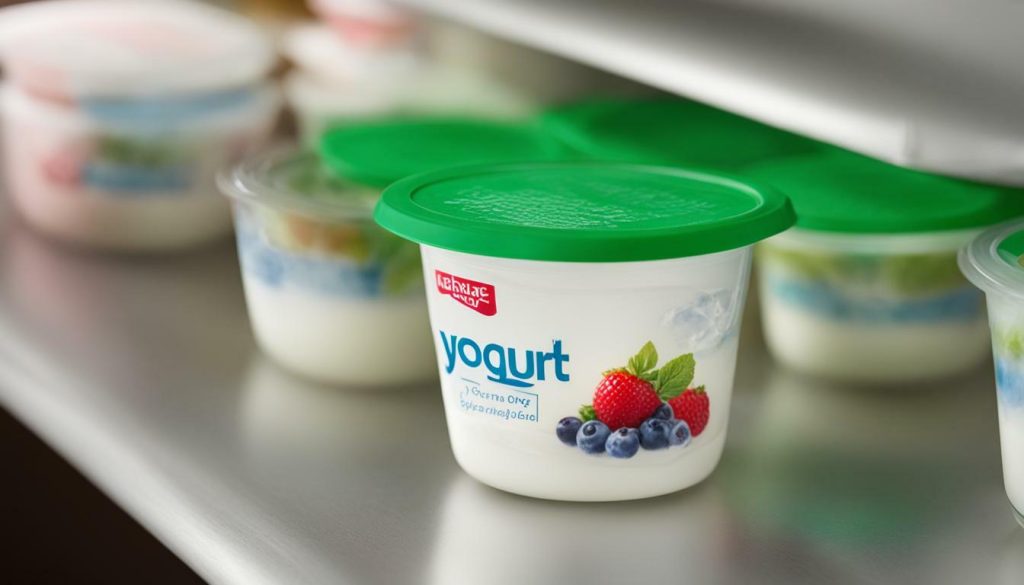Are you curious about how long yogurt can sit out without spoiling? Understanding the shelf life and safe time for yogurt is essential to ensure you enjoy it while it’s fresh and safe to consume.
Factual data: Yogurt can sit out at room temperature for up to two hours before it must be refrigerated. However, if the temperature is 90°F or above, yogurt should only sit out for one hour. Storing yogurt on a shelf toward the back of the fridge where temperatures are cooler and setting the refrigerator to a temperature of 40°F or below can help extend its shelf life. Yogurt can last one to two weeks when stored in the refrigerator and up to two months when frozen. It is important to note that yogurt with added sugar and fruit may experience faster bacterial growth. Eating yogurt that has been left out for too long can lead to food poisoning, causing symptoms such as diarrhea, cramps, and vomiting. Signs that yogurt has gone bad include an increase in liquid whey, curdling texture at the bottom, formation of mold or fungus, and a bad smell. It is recommended to store yogurt in the refrigerator and discard any yogurt that shows signs of spoilage.
Key Takeaways:
- Yogurt can sit out at room temperature for up to two hours before refrigerating.
- If the temperature is 90°F or above, yogurt should only sit out for one hour.
- Storing yogurt at cooler temperatures in the back of the refrigerator can extend its shelf life.
- Yogurt can last one to two weeks when stored in the refrigerator.
- Freezing yogurt can extend its shelf life up to two months.
- Be cautious of bacterial growth in yogurt with added sugar and fruit.
- Signs of spoiled yogurt include an increase in liquid whey, curdling texture, mold or fungus, and a bad smell.
Factors Affecting Yogurt Shelf Life and Safe Time
Several factors can influence how long yogurt can be left out before it spoils, from storage temperature to the potential growth of bacteria. Proper understanding of these factors is crucial to ensure the safety and quality of yogurt.
The storage temperature plays a significant role in determining the shelf life of yogurt. Bacterial growth in yogurt is slowed down when stored at temperatures below 40°F. Setting your refrigerator to this temperature can help extend the freshness of yogurt. On the other hand, if yogurt is left out at room temperature, especially in environments with temperatures of 90°F or higher, bacterial growth accelerates, and the safe time for yogurt to sit out is reduced to one hour.
Bacterial growth is a natural process that occurs in yogurt, and it can lead to spoilage if not kept in check. The longer yogurt sits out at temperatures conducive to bacterial growth, the higher the risk of food poisoning. It is important to note that yogurt with added sugar and fruit may experience faster bacterial growth compared to plain yogurt.
To further extend the shelf life of yogurt, proper storage practices are essential. Storing yogurt on a shelf towards the back of your refrigerator, where temperatures are typically cooler, can help maintain its freshness. Refrigerated yogurt can last anywhere from one to two weeks, depending on the quality and condition of the yogurt at the time of purchase.

It is worth mentioning that freezing yogurt is also an option for extended storage. When frozen, yogurt can last up to two months but may undergo some texture changes. Freezing can be particularly useful if you have excess yogurt that you want to preserve for later use, or if you come across a great deal and want to stock up.
It is important to be aware of the signs that indicate yogurt has gone bad and should be discarded. Watch out for an increase in liquid whey, curdling texture at the bottom, the formation of mold or fungus, or a bad smell. If you notice any of these signs, it is best to err on the side of caution and dispose of the yogurt to prevent foodborne illnesses.
Recommended Storage Practices for Yogurt
To maximize the shelf life and freshness of your yogurt, it’s crucial to follow recommended storage practices. Proper storage not only keeps your yogurt safe to consume but also ensures that it maintains its taste and texture over time. Here are some essential guidelines to keep in mind:
- Refrigerate promptly: After purchasing or opening a container of yogurt, make sure to refrigerate it promptly. Yogurt should be stored at a temperature of 40°F or below to slow down bacterial growth and preserve its quality.
- Choose the right spot in your fridge: Store your yogurt towards the back of the refrigerator, as this area tends to be cooler and more consistent in temperature. Avoid placing it in the refrigerator door, as this area is subject to temperature fluctuations whenever the door is opened.
- Keep it sealed: Once you’ve opened a container of yogurt, ensure it is tightly sealed to prevent exposure to air and potential contamination. If the original container doesn’t have a secure lid, transfer the yogurt to an airtight container for storage.
- Maintain cleanliness: Before consuming or handling yogurt, make sure your hands, utensils, and storage containers are clean. Contaminants can accelerate the spoilage process, so practicing good hygiene is essential.
By following these recommended storage practices, you can extend the shelf life of your yogurt and keep it fresh for longer. Remember that the storage time may vary depending on the type of yogurt and any added ingredients, such as sugar or fruit. Always check for signs of spoilage before consuming yogurt that has been stored for an extended period.

Table: Shelf Life of Different Types of Yogurt
| Type of Yogurt | Refrigerator Shelf Life |
|---|---|
| Plain Yogurt | 1-2 weeks |
| Greek Yogurt | 1-2 weeks |
| Flavored Yogurt | 1 week |
| Fruit Yogurt | 5-7 days |
Table: The shelf life of yogurt may vary depending on the type and any added ingredients. It’s important to note that these are general guidelines, and individual products may have slightly different recommendations. Always check the label or manufacturer’s instructions for specific storage recommendations.
How Long Can Yogurt Sit Out?
Wondering how long you can leave yogurt out before it starts to spoil? The general rule is that yogurt can sit out at room temperature for up to two hours, but there are factors to consider. One of the most important factors is temperature. If the room temperature is 90°F or above, it is best to refrigerate yogurt within one hour to prevent bacterial growth and maintain its freshness.
Proper storage practices can also play a significant role in extending the safe time for yogurt. Storing yogurt on a shelf toward the back of the fridge where temperatures are cooler can help prolong its shelf life. It is recommended to set the refrigerator temperature to 40°F or below, as this helps maintain the freshness and quality of yogurt. By following these storage guidelines, you can ensure that your yogurt stays safe and delicious.
It is worth noting that the shelf life of yogurt can vary depending on various factors, including the type of yogurt and its ingredients. Yogurt with added sugar and fruit may experience faster bacterial growth and spoil more quickly. Therefore, it’s essential to check the label and follow any specific storage instructions provided by the manufacturer.
When yogurt is left out for an extended period, it can become a breeding ground for harmful bacteria, leading to food poisoning. The symptoms of food poisoning can range from mild to severe and may include diarrhea, abdominal cramps, and vomiting. To ensure food safety, it’s crucial to discard any yogurt that has been left out for too long or shows signs of spoilage. Indicators of spoiled yogurt include an increase in liquid whey, curdling texture at the bottom, formation of mold or fungus, and a bad smell. Trust your senses and always prioritize your health when it comes to consuming yogurt.

- Yogurt can sit out at room temperature for up to two hours, but the time may be reduced to one hour if the temperature is 90°F or above.
- Storing yogurt in the refrigerator towards the back and setting the temperature to 40°F or below can help extend its shelf life.
- Yogurt can last one to two weeks when properly stored in the refrigerator and up to two months when frozen.
- Yogurt with added sugar and fruit may spoil more quickly due to faster bacterial growth.
- Signs of spoiled yogurt include an increase in liquid whey, curdling texture, mold or fungus formation, and a bad smell.
- Always discard yogurt that shows signs of spoilage to prevent food poisoning.
| Temperature | Safe Time for Yogurt |
|---|---|
| Below 90°F | Up to 2 hours |
| Above 90°F | Up to 1 hour |
Shelf Life of Yogurt in the Refrigerator
When refrigerated at the right temperature, yogurt can stay fresh for a significant period, allowing you to enjoy it over a week or even longer. Proper storage is key to maintaining yogurt’s quality and extending its shelf life.
Storing yogurt in the refrigerator helps slow down the growth of bacteria and preserves its freshness. It is recommended to set your refrigerator temperature to 40°F (4°C) or below to ensure optimal conditions for yogurt storage. Keeping yogurt towards the back of the fridge, where temperatures are cooler and more consistent, can also help maintain its quality.
It is important to note that different types of yogurt may have varying shelf lives. Regular yogurt typically lasts one to two weeks when stored in the refrigerator. However, Greek yogurt, due to its higher protein content and lower moisture, tends to have a longer shelf life and can stay fresh for up to two weeks or even slightly longer.
When refrigerating yogurt, it is essential to check for signs of spoilage before consuming. If the yogurt shows any signs of mold, an off smell, or an increased separation of liquid whey, it is best to discard it to avoid any potential foodborne illnesses. Consuming spoiled yogurt can lead to stomach discomfort, including symptoms like diarrhea, cramps, and vomiting.

- Always check the expiration date before purchasing yogurt to ensure freshness.
- Store yogurt in airtight containers or keep it sealed in its original packaging.
- Avoid placing yogurt containers near foods with strong odors, as yogurt can easily absorb them.
- Do not freeze and thaw yogurt repeatedly, as this can affect its texture and quality.
- Keep track of the date you opened the yogurt container to help monitor its freshness.
| Yogurt Type | Shelf Life in the Refrigerator |
|---|---|
| Regular Yogurt | 1 to 2 weeks |
| Greek Yogurt | Up to 2 weeks or slightly longer |
By following these storage tips and paying attention to the signs of spoilage, you can enjoy fresh and delicious yogurt for an extended period. Remember to check the shelf life of your yogurt and consume it before it reaches its expiration date for the best taste and quality.
Freezing Yogurt for Extended Storage
If you want to extend the shelf life of your yogurt even further, freezing can be a great option. Freezing yogurt can help you keep it fresh for up to two months, allowing you to enjoy it at a later time. While freezing can alter the texture of yogurt slightly, it is still a convenient way to ensure you have yogurt readily available when you need it.
To freeze yogurt, start by transferring it into an airtight container or freezer-safe bag. Make sure to leave some space at the top as yogurt can expand when frozen. Seal the container or bag tightly to prevent any air from getting in, which can lead to freezer burn.
When it comes to thawing frozen yogurt, it is best to place it in the refrigerator overnight. This slow thawing process helps maintain the yogurt’s texture and flavor. Avoid thawing yogurt at room temperature or using a microwave, as this can lead to uneven thawing and affect the quality of the yogurt.
Remember to label your frozen yogurt with the date it was frozen to keep track of its freshness. It is also a good idea to keep a rotation system in place, consuming the oldest yogurt first to ensure you are always enjoying the freshest product.

Freezing yogurt not only extends its shelf life, but it also provides you with flexibility in meal planning. You can freeze individual portions of yogurt to use in smoothies, parfaits, or as a healthy snack alternative. It is a convenient way to have yogurt on hand whenever you need it, without worrying about it going bad.
Notes on Frozen Yogurt
It is important to note that freezing may cause some separation in the yogurt, leading to a slightly grainy texture upon thawing. This is a natural occurrence and does not affect the taste or safety of the yogurt. Stir the thawed yogurt gently to reincorporate any separated liquid.
While frozen yogurt can be enjoyed on its own, it may not be suitable as a substitute for fresh yogurt in recipes that require a smooth and creamy texture. However, it can still be used in cooking and baking applications where the texture is less crucial, such as in smoothies, frozen desserts, or baked goods.
To make the most out of your yogurt’s shelf life, consider freezing it in small portions for easy thawing and consumption. By doing so, you can always have yogurt available whenever the craving strikes.
| Benefits of Freezing Yogurt | Notes on Frozen Yogurt |
|---|---|
| – Extends shelf life | – Slight texture change upon thawing |
| – Enhances meal planning flexibility | – Stir gently to reincorporate separated liquid |
| – Convenient for smoothies, parfaits, and snacks | – May not be suitable for recipes requiring smooth texture |
| – Always have yogurt available when needed | – Freeze in small portions for easy thawing |
Signs of Spoiled Yogurt and When to Discard
It’s essential to recognize the signs of yogurt spoilage to avoid consuming yogurt that may cause food poisoning. When yogurt goes bad, it can harbor harmful bacteria that can lead to unpleasant symptoms like diarrhea, cramps, and vomiting. To ensure your safety, here are some indicators that your yogurt has spoiled and should be discarded:
- An increase in liquid whey: If you notice a significant amount of liquid separated from the yogurt, it is a sign of spoilage.
- Curdling texture at the bottom: When the bottom of the yogurt container shows a lumpy or curdled texture, it is an indication that the yogurt has gone bad.
- Formation of mold or fungus: Visible mold or fungus growing on the surface of the yogurt is a clear sign of spoilage. It is important to note that some types of molds can be toxic, so it’s best to discard the yogurt immediately.
- Unpleasant smell: If your yogurt emits an off-putting aroma, it is likely that the bacteria have multiplied, indicating spoilage.
When you encounter any of these signs, it’s crucial to dispose of the yogurt to prevent potential foodborne illnesses. Remember, consuming spoiled yogurt can have adverse health effects, causing discomfort and disrupting your digestive system.
Incorporating healthy food habits, such as proper storage and regular check-ups for signs of spoilage, can help ensure your yogurt remains safe to consume. By following these guidelines, you can enjoy fresh and delicious yogurt without compromising your well-being.

Conclusion
Proper storage practices and knowledge of how long yogurt can sit out are crucial to enjoy fresh and safe yogurt whenever you desire.
When it comes to leaving yogurt out, it is important to remember that yogurt can sit at room temperature for up to two hours before it must be refrigerated. However, if the temperature reaches 90°F or above, it is best to limit the time to just one hour. This helps to prevent the growth of harmful bacteria.
To extend the shelf life of yogurt, it is recommended to store it on a shelf towards the back of the refrigerator, where temperatures are cooler. Setting the refrigerator to a temperature of 40°F or below also helps in prolonging yogurt’s freshness. By following these storage practices, yogurt can last one to two weeks when stored in the refrigerator.
If you find that you have more yogurt than you can consume within that timeframe, freezing is an option. Frozen yogurt can last up to two months, although it may undergo some texture changes. Freezing is a great way to keep yogurt fresh for a longer period.
It is important to note that yogurt with added sugar and fruit may experience faster bacterial growth. Eating yogurt that has been left out for too long can lead to food poisoning, causing symptoms such as diarrhea, cramps, and vomiting. Always be cautious and discard any yogurt that shows signs of spoilage, such as an increase in liquid whey, curdling texture at the bottom, formation of mold or fungus, or a bad smell.
By following these guidelines and being mindful of yogurt’s shelf life, you can ensure that every spoonful of yogurt you indulge in is delicious and safe. Enjoy your yogurt knowing that you have stored it properly and taken the necessary precautions to prevent any foodborne illnesses.
FAQ
How long can yogurt sit out before it needs to be refrigerated?
Yogurt can sit out at room temperature for up to two hours before it must be refrigerated. However, if the temperature is 90°F or above, yogurt should only sit out for one hour.
Where is the best place to store yogurt in the refrigerator?
It is recommended to store yogurt on a shelf toward the back of the fridge where temperatures are cooler. Setting the refrigerator to a temperature of 40°F or below can help extend its shelf life.
How long does yogurt last when stored in the refrigerator?
Yogurt can last one to two weeks when stored in the refrigerator.
Can yogurt be frozen for long-term storage?
Yes, yogurt can be frozen for up to two months. However, it may undergo some texture changes.
What are the signs that yogurt has gone bad?
Signs that yogurt has gone bad include an increase in liquid whey, curdling texture at the bottom, formation of mold or fungus, and a bad smell. If you notice any of these signs, it is best to discard the yogurt.




